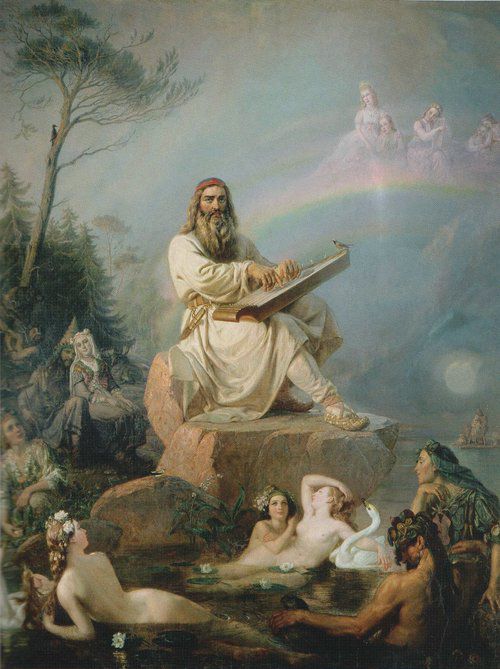We take a look at the history of art in Scandinavia and the Nordic regions through time, picking our favourites from each country.
Sweden
In the late 19th and 20th century, Swedish art started to become internationally recognised and it was the Stockholm Exhibition of 1930 which really pushed it to centre stage, giving rise to the Functionalist movement – the forerunner to the Scandi style, which is so popular today. Some of Sweden’s most famous artists include neoclassical sculptor Johan Tobias Sergel (1740–1814); watercolour painter Carl Larsson (1853–1920); and Anders Zorn (1860–1920), who was famous for his nude paintings.
Works by Carl Larsson can be seen at The Gothenburg Museum of Art and the Thiel Gallery in Stockholm, Sweden, which also showcases work by Anders Zorn. One can’t help thinking of the Swedish arts however, and not have the songs of 70’s pop band ABBA come into their head – winners of the Eurovision Song Contest and nine No. 1 UK hits. And, of course, everyone knows the works of Swedish author Astrid Lindgren (1907–2002) through her tales of feisty redhead Pippi Longstocking. More recently, Stieg Larsson's The Girl with the Dragon Tattoo and its sequels have gained critical acclaim for the thrilling exploits of protagonists Mikael Blomkvist and Lisbeth Salander.
Visit Gothenburg and Stockholm on a six-day cruise along the Göta canal for a culture-rich journey through Sweden.
Norway
One of the most famous artists to have come out of Norway is Edvard Munch (1863–1944), one of the great expressionists, who is best known for his painting The Scream. Other well-known Norwegian painters include JC Dahl (1788–1857), considered to be Norway’s first great romantic painter; Adolph Tidemand (1814–1876), known for his romantic nationalistic paintings; and Hans Gude (1925–1903), one of Norway’s leading landscape painters.

Edvard Munch's 'The Scream'
Norway has also made a great contribution to literature and has had several Nobel Prize winners, including Sigrid Undset (1882–1949), Knut Hamsun (1859–1852) and Bjornstjerne Bjornson (1832–1910). The most famous of these, however, is Norwegian playwright Henrik Ibsen (1829–1906), author of plays such as A Doll’s House. Visit Norway to see some its artistic contributions at the National Museum of Contemporary Art in Oslo, the Munch Museum and the Vigeland Museum, the world’s largest sculpture park made by a single artist – Gustav Vigeland.
Denmark
Although Denmark produced some early notable Norse and Viking art, it wasn’t until the Danish Golden Age (early 19th century) that a distinct national style began to emerge. One of the most important figures during this time was C.W. Eckersberg, know as ‘the father of Danish painting’. Some of the most important pieces of Danish art can be seen in The National Museum Copenhagen, Denmark and The National Gallery of Denmark. In Danish literature, one name sticks out above the rest – children’s author Hans Christian Andersen (1805–1875), who famously wrote such tales as The Little Mermaid and The Emperor’s New Clothes, which are still read and loved by children today.
Finland
Like Denmark, Finland enjoyed a Golden Age, from the turn of the 19th century to the 20th century, which gave rise to a number of important artists. One of the most famous was Robert Wilhelm Ekman (1808-1873), dubbed the ‘pioneer’ and ‘father’ of Finnish fine arts. Another was Jean Sibelius (1865–1957), a celebrated musician and composer who wrote Finlandia, one of the country’s most notable pieces of music, created as a protest against increasing censorship from the Russian Empire. Poet and journalist Eino Leino (1878–1926) also made a great contribution to Finnish arts through his poems about folklore. In more recent history, most of us are familiar with the works of author and illustrator Tove Jansson (1914–2001), and her loveable Moomins.

Robert Wilhelm Ekman's 'Väinämöisen soitto'
Visit Finland to see works by some of its best artists at the Finnish National Gallery in Helsinki and the Helsinki City Art Museum. Also worth a visit is the Helsinki DESIGNMUSEUM, showcasing some of Finland’s unique modern design.
Iceland
Iceland has probably made the greatest contribution to the arts through music. Many bands and singers such as Bjork, Sigur Ros and Emiliana Torrini have found international acclaim with their unique styles. As well as its music, Iceland has produced some great fine artists – the most influential of which are Erró – (1932–), a postmodern pop artist; landscape painter Jóhannes S. Kjarval (1885–1972); and sculptor Ásmundur Sveinsson (1893–1982). Works by all three are displayed in the Icelandic capital at the Reykjavik Art Museum, housed in three distinct buildings named after each.
Interested in experiencing of Scandinavia's fascinating art and culture? Browse our holidays by destination or call us for ideas and inspiration for your next tailor-made adventure.
